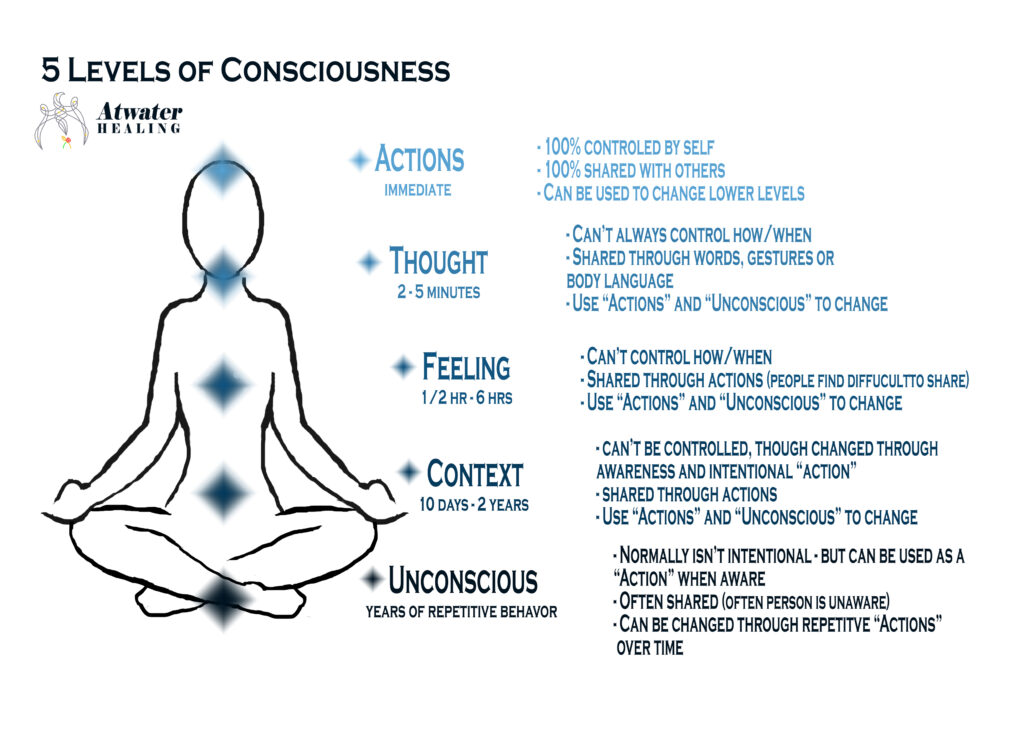
Forest Animal Transformations: Fox
Start your day off right with a guided meditation. Listen to new meditations weekly, or become a patron member to access our entire library.


The foundational tool that all our other methods are based on.

We divide consciousness into 5 levels based on how much awareness and how much control we have over that part of ourselves. As you go deeper through the levels, you are generally less aware of how the level is affecting you and the more it feels like these things are an unchangeable part of yourself. The 5 Levels of Consciousness are as follows:
Actions are everything we consciously do or say. These are things we are aware of, actions we choose to take and words we choose to speak. This is the most visible level of consciousness, completely on the surface. When we are acting, anyone who is around us can watch and draw conclusions. This means Level 1 is a completely shared level.
Also, although it may not always feel like it, Level 1 is completely under our control. Because this level is made up only of actions we are conscious of, we must consciously choose each word we say and every action we take.
Thoughts are the first internal, invisible level of consciousness. Our thoughts occur inside of us, and no one can hear your thoughts or read your mind, no matter how much we wish our spouses, partners, or children could. We are generally aware of our thoughts, at least if we turn our attention to them. We can convert our thoughts into words, although imperfectly, in order to share them with others, so thoughts are a somewhat shared level of consciousness. We share thoughts using actions, both words and deeds. We say, therefore, that Level 2 is shared through Level 1.
Our thoughts are not as much under our control as our actions. Thoughts occur to us all the time, introduced by other people, media, or just randomly it seems. While we may choose to think specific things, not every thought is a choice we make. Therefore, Level 2 is not completely under our control.
Feelings are the second internal, invisible level of consciousness. Like our thoughts, our feelings occur inside of us. We are sometimes aware of our feelings and other times we are almost completely unaware of them. Also, like our thoughts, we can sometimes convert our feelings into words, although imperfectly, in order to share them with others. We do, however, sometimes have feelings that we have no words for and therefore are unable to express or even acknowledge. So feelings are an even less shared level of consciousness than our thoughts though still shared to a small degree. We share feelings using actions, both words and deeds. We say, therefore, that Level 3 is shared, when we have sufficient vocabulary, through Level 1.
Our feelings are not under our control as our actions or even our thoughts are to some degree. We are constantly experiencing feelings, either as a sensation or as an emotion. These feelings result from influences from other people, media, other levels of consciousness or just randomly it seems. While we may choose to do, say or think specific things, we do not choose our immediate feelings. Therefore, Level 3 is not under our control.
Context is the third internal, invisible level of consciousness. We are generally unaware of our contexts, unless we turn our attention to them and even then we sometimes cannot understand or become aware of a context without outside observers helping us to see them. Once we become aware of a context we can convert them into words, although like thoughts often imperfectly, in order to share them with others. Sometimes others can observe our own contexts while we are unaware of them. We share contexts using actions, both words and deeds. We say, therefore, that Level 3 can be shared through Level 1 once we are made aware of it.
We cannot control our contexts which are established over time through our culture, upbringing, family, background, environment, etc. Like our feelings contexts are not under our immediate control but we can use our actions to change a context though this is very difficult and usually takes a lot of time. Contexts can only be intentionally changed through repetitive actions and after one has become aware of the context in question. Therefore, Level 4 is not under our control.
The unconscious is everything we do unawares. These are things we are unaware of, actions we do without thinking about it at all. After actions, unconscious is the most visible level of consciousness, mostly on the surface. Actions like walking, riding a bike, breathing and blinking are all unconscious as we do them without needing to think about them to make the happen. Level 5 is a mostly shared level where we tend to be unaware of what or how we are doing but others are aware.
Also, although it may not always feel like it, Level 5 is completely under our control when we choose to make ourselves aware of the unconscious actions. However, when we don’t make ourselves aware we give up control and allow our physical bodies to take control without our own awareness.
Watch the latest episode of our Q&A podcast. Archived episodes can be found on the vlog/podcasts page.
Watch the first lesson of our available classes.